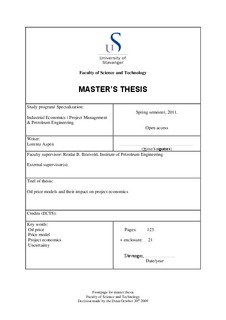| dc.description.abstract | When assessing values of petroleum projects, a key parameter is the oil price at which the extracted petroleum can be sold at. Many companies use a corporate planning price in their calculations. This price is more often estimated by a fixed price model than a more realistic model. History has shown that the oil price for the past forty years has been anything but stable and is constantly reacting to many different factors, such as war, politic upheavals, speculation and also to industry occurrences such as refinery constraints, oil spills, and discoveries. Consequently all of these events influence the balance in supply and demand, where the imbalance and future outlook is reflected in the price of oil. The choice of using a fixed price level to value projects, fails to embrace the volatility and uncertainty in the oil price and will subsequent lead too poor project evaluation as these features are not reflected in a projects value.
The work in this thesis has been to investigate and compare the behaviour and the uncertainty of four price models which offer different levels of detail and complexity; Fixed Price, Geometric Brownian Motion, Mean Reversion and a System Thinking approach. Using system thinking has not yet been popularized in price modelling. Much effort has therefore gone into establish and refine this model as the level of complexity and detail in this approach requires a reasonable amount of data and understanding.
To compare and evaluate how the models impact project economics, three realistic petroleum projects with different attributes were selected to perform analysis on; Knarr (Norway), Tawke (Kurdistan); Tiber (USA).
The selected price models, all but one, show to contribute to over 50% of the total uncertainty in a projects value. As a consequence, a price model used in project economics should therefore have uncertainty associated to it in order to reflect the possible values different price scenarios could impose in a project.
Two of the models are chosen as recommended models from this thesis work; The Mean Reversion (MR) model and the System Thinking (ST) approach. The Mean Reversion model used here offers a larger uncertainty range, but fails to embrace an increasing trend in the price. The System Thinking Model shows an increasing trend and has a reasonable uncertainty range; however it fails to embrace lower price levels.
The uncertainty in price models is highly influential to the valuation of projects. It is therefore vital to implement a realistic price model with uncertainty when assessing projects. The choice of model should be approached with respect to historic data and attuned for present and future outlook. | no_NO |
